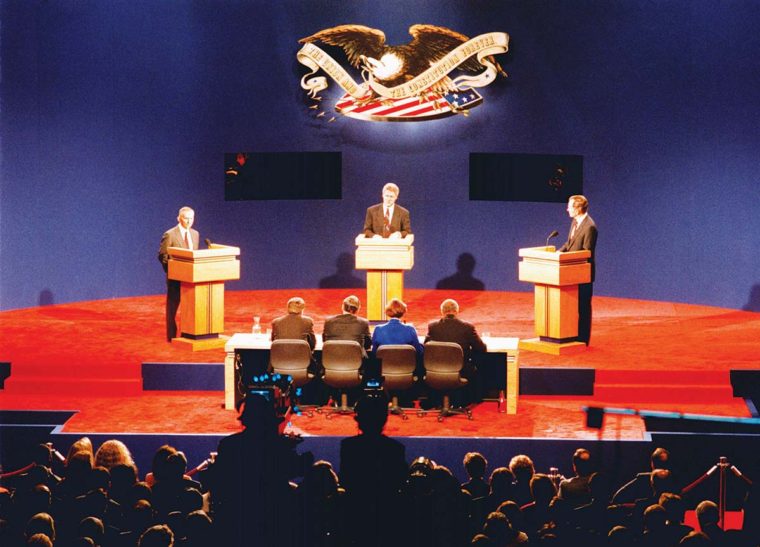The gold standard
WashU will host a debate for the fifth time this October. Here, we look back at our past debates.
On Oct. 2, 1992, President George H.W. Bush’s and Gov. Bill Clinton’s campaigns finally reached an agreement about the debate schedule. But the first debate would be Oct. 11, and there was no venue. Janet Brown, executive director of the Commission on Presidential Debates (CPD), called then–Missouri Sen. Jack Danforth. (She had once been his press secretary.)
“I was told … that if we could raise half a million dollars in a couple of hours, we could get the first debate in St. Louis,” Danforth later told the Chicago Tribune. “It was Friday afternoon, and I knew that I was on a very tight time schedule.” He called August A. Busch III, chairman and president of Anheuser-Busch, and within half an hour had secured the half million dollars. He also called his brother, William H. Danforth, then chancellor of WashU, and told him that the CPD would be looking for a site in St. Louis.
The commission visited Oct. 4 and told Washington University that afternoon that it would host the debate in seven days. Through a coordinated and herculean effort, the university transformed its Athletic Complex into a TV studio and accommodated the needs of every major TV studio and thousands of journalists, aides, campaign staffers and volunteers. It went so well that when the CPD picks debate sites, Washington University is usually on the short list. We were also selected as a debate site in 1996 (canceled at the last minute), 2000, 2004, 2008 (vice presidential debate) and now again in 2016.
“This campus is the gold standard for debates,” Janet Brown said back in 2004. And Washington University just keeps raising the bar.
To find debate information and celebrate with WashU, visit debate.wustl.edu.

DEBATE DID YOU KNOW
WashU debate with the most viewers
69.9 million viewers | 2008 vice presidential debate between Democrat Joe Biden and Republican Sarah Palin
WashU debate with the fewest viewers
37.7 million viewers | 2004 presidential debate between Republican George W. Bush and Democrat John Kerry
Air-conditioning played a key role
One of the requirements for a debate site is that the room can be cooled to at least 70 degrees to mitigate the heat from all the lights. When the debate commission came in 1992, the air-conditioning in the Athletic Complex had already been shut off but was quickly flipped back on. For the curious, the Field House is usually a chilly 65 degrees for the debate.
We had to clean up after a party
The debate commission visit in 1992 was the day after the university’s homecoming, which included a parade, tailgate party, football game and dance. William Wiley, manager of maintenance, spiffed up the grounds in time for the 11:30 a.m. visit.

You can keep your eyes peeled for candidates
In 1992, Gov. Bill Clinton jogged from his hotel to Forest Park along Forsyth Blvd. Maybe if he returns with his wife and Democratic presidential nominee, Hillary Clinton, in October, there could be a second spotting.
Students meet the future president
Every debate, the president of Student Union gets to present both candidates with WashU swag and welcome the audience to the debate. The chancellor also says a few words as well as a faculty member and someone from the CPD.
That stage doesn’t just look the same
From debate to debate, the stage remains the same. When it is taken down, it is shipped to the subsequent venues.
Excluded candidates still get the floor
In 2000, when Ralph Nader was running with the Green Party, the CPD excluded him from the debates, but he spoke at 5 p.m. at Northmoor Park the day of the debates anyway.
Debate prep has changed
In 1992, the university installed 12,500 phone lines — now primarily mobile cell phone towers are used.
In 1992, the university turned showers into photo-developing and -transmitting facilities and had student volunteers running film from the debate hall to the labs — now it’s all digital.
Students made a shirt in 1992 for the top 10 reasons they missed the debate. Reason No. 3 was, “babysitting Murphy Brown’s baby” — a reference lost on today’s students.
Previously, placards were hung around campus with debate updates — now people just visit debate.wustl.edu.
